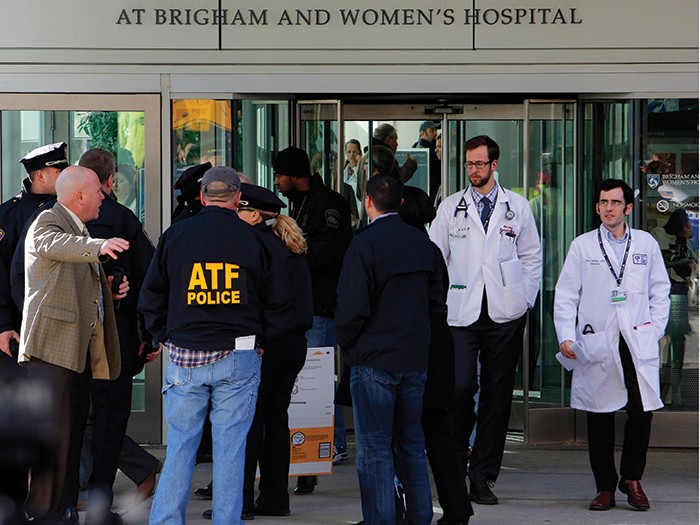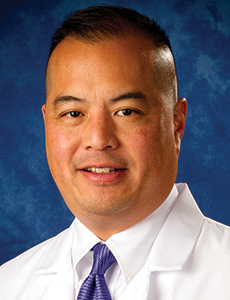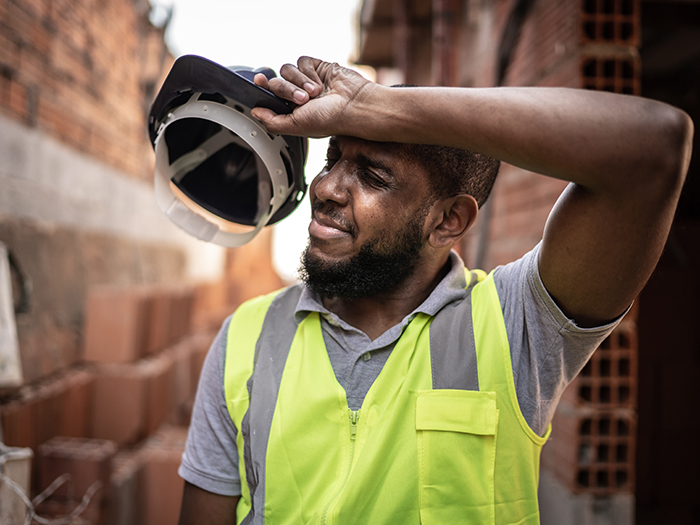Workplace Violence
Rx for Violence

Law enforcement responded to Brigham and Women’s Hospital in Boston on Jan. 20, 2015, where a cardiologist was killed.
Dr. Jeffrey Ho treats patients in a busy Level 1 trauma center at the Hennepin County Medical Center in Minneapolis, and he teaches emergency medicine at the University of Minnesota Medical School. He’s also a sworn deputy sheriff in neighboring Meeker County.
The combination of medical practice and law enforcement is not the contradiction it might seem.
It led to his belief that the most effective strategy for preventing violence was not necessarily more deterrence in the form of weapons and armed security, but more and better training in violence recognition and pre-emption for people who dedicate themselves to the helping professions: doctors, nurses, technicians, administrators and therapists, as well as support staff such as receptionists and maintenance crews.
Health care workers are injured through violent acts at more than four times the national rate, according to the U.S. Bureau of Labor Statistics. FBI statistics show the incidence of active shooter incidents in health care settings rose from 6.4 per year between 2000 and 2006, to 16.4 per year between 2007 and 2013.
Those numbers are a gross underestimate, Ho said, because the health care culture doesn’t yet take assaults seriously, other than the deadly ones. OSHA doesn’t break out violence in its statistics on injuries to workers, although it breaks out other sources of injury. And workers themselves don’t consider minor incidents worth reporting.
When he consults with other hospitals on beefing up security — another of his jobs, along with his role as medical director for TASER International — Ho asks caregivers, “Has a patient ever threatened you or has anybody ever touched you?”
“Every hand goes up,” he said. Then he asks how many times they’ve reported it. “Nobody raises a hand,” he said.
A Big Problem, But How Big?
When an accurate registry of incidents exposes the pervasiveness and severity of the problem, Ho said, hospital administrations, the insurance industry, the government and general public will be shocked into corrective action.
However, obstacles to accurate reporting are nearly as pervasive as the violence itself.
The main reason violent incidents are under-reported, said Barry Weiner, managing director, health care practice leader, Aon, is that there is no mandate for facilities to report all events.
For those that report anyway, there is no universal definition of a reportable (or recordable) injury, said Jane Lipscomb, professor at the University of Maryland Schools of Nursing and Medicine, and author of “Not Part of the Job: How to Take a Stand Against Violence in the Work Setting.”
OSHA has one set of requirements, workers’ compensation carriers may have another and facilities may have their own.
“What’s an ‘event’?” asked Weiner. “Every emergency department sees a half-dozen on a good night, but won’t report all of them. Where is the threshold for reportable incidents?”
“We had to get staff to understand that behaviors that would be criminal in other settings are not OK just because they happen in a hospital.” — Dr. Jeffrey Ho, Hennepin County Medical Center
Many victims, particularly nurses, don’t report staff-on-staff incidents for fear of retaliation, said Lori Severson, health care loss control consultant, Lockton Cos.
An Institute for Safe Medication Practices study finds a virtual epidemic of violence, intimidation and passive aggression by health care workers, who may be stressed out by accountability for life-and-death procedures.
A dysfunctional team, said Lipscomb, is more apt to make errors, which may expose the organization to litigation. “Increasingly, organizations recognize that staff safety and patient safety are closely linked.”
Obstacles to Reporting
Electronic medical records, mandated by the Affordable Care Act for patient records, may contribute to the problem, said Weiner, as hospitals may have a disincentive to record incidents.
“Discoverability can be an issue,” he said. “An electronic record is permanent and discoverable. Both sides can use it in a courtroom.”
Not infrequently, Severson said, a repeat offender cycles through a facility again and again. “Health care workers may then feel workplace violence reporting isn’t a solution but an empty motion. Why report the same person multiple times?” she asked.
Veterans Affairs facilities electronically flag the file of patients who have acted out violently against staff in the past two years, and security personnel escort them whenever they’re in a facility for treatment, according to published reports.
The financial ramifications of violence combined with the need to protect employees create an urgent problem. A broker’s role, said Weiner, is to work with clients to scope out the problem.
“Some of the solution lives with us. We deliver training, promote best practices and engage leadership in meaningful discussion about reducing violence.”
Responsibility for the so-far nonexistent registry of assaults, Ho said, doesn’t belong with a government agency, but with a professional risk association.
The American Society for Healthcare Risk Management was unavailable for comment.
But a professional association faces the same obstacles as OSHA, the Department of Labor, the Crime Victimization Survey and the “other organizations out there trying to make good estimates,” said Lipscomb. “Staff don’t report if they work in an environment where they think violence is part of their job, where reporting is risky, and where it won’t produce results anyway.”
Disrupting the vicious cycle of under-reporting and perpetuation of violence, Lipscomb said, usually depends on a facility’s enlightened leadership, without whose commitment of time, resources and adequate staffing to meet patients’ needs, culture change is “nearly impossible.”
The organizations she visited to identify best practices, she said, have many things in common, such as morning huddles every day, when CEOs and unit heads get together to talk about what happened in last 24 hours. “They ask, ‘What do we need to do to make sure it doesn’t happen again?’ ”
“Staff don’t report if they work in an environment where they think violence is part of their job, where reporting is risky, and where it won’t produce results anyway.” — Jane Lipscomb, professor, University of Maryland Schools of Nursing and Medicine
This is already common practice with patient care. Taking their cue from aviation and other safety-essential industries, they have adopted a culture where errors and near misses are considered opportunities to improve the facility’s practice.
“That’s how you get people to report,” Lipscomb said. “Then you can do something about the problem.”
Changing Behaviors
Ho’s facility has done “a good job” controlling violence, thanks to senior management’s follow-up on recommendations from a violence prevention task force formed in 2007. The task force’s recommendations start with a carrot (de-escalation) and end with a stick (force). The longest journey, he said, was training staff members to consider their own safety.
Having been taught for years that verbal abuse and getting punched in the face by a distraught patient or family member is simply an occupational hazard, the forgivable by-product of grief or pain, “we had to get staff to understand that behaviors that would be criminal in other settings are not OK just because they happen in a hospital.”
In fact, several states have passed legislation making any attack on a health care worker a felony. Although there is no federal standard for workplace violence protections, according to the American Nurses Association, some states require employer-run workplace violence programs. Washington is the only state to require reporting of incidents.
Among the Hennepin County Medical Center task force’s recommendations: Signage around the facility stating appropriate behavior.
The Joint Commission, a national certifying organization, now requires its accredited hospitals to have a code of conduct that identifies appropriate behaviors and how inappropriate behavior should be managed.
Training helps staff recognize risks, such as frustration with long ER wait times, intoxication and drug-seeking behavior, according to experts.
It teaches empathetic listening, the most basic de-escalation technique, which means the distraught person has no need to act out in violent ways to be heard, said Elizabeth Moreland, senior risk engineering consultant, Zurich Insurance.
Emergency rooms and mental health settings are particularly high-risk areas, experts said, but “everyone who has patient contact should get basic crisis prevention awareness training,” said Moreland.
Some organizations, such as the Crisis Prevention Institute (CPI), provide training specific to health care facilities. Typically, a facility sends one or two staff members for training, and they return to spread the gospel.
The National Institute for Occupational Safety and Health, the Centers for Disease Control and Prevention, and some trade associations offer free programs and best practices to help manage health care violence.
Training typically includes rehearsing non-judgmental and non-provocative responses to a distraught person’s demands. Body language can also diffuse emotions, Moreland said. For example, standing to a person’s side is a less confrontational posture than standing nose to nose.
For most people, these techniques require practice, she said. “In-service role-playing is very effective. Don’t depend on once-a-year training sessions.”
People, Not Livestock
Batsheva Katz, vice president of Windsor Healthcare Communities, which runs elder care, skilled nursing and rehabilitation facilities in New Jersey, takes pains to provide “a happy environment” as the most effective prevention against violence.
Biting, hitting, pushing and scratching are typical assaults in residential facilities, where emotions run high among residents and their families as they face the fear of mortality and the discomforts and humiliations of aging.
“Happiness” in those circumstances is a systematic, top-down effort to treat residents “as someone’s mother or father,” rather than as bodies that need to be fed and washed, Katz said.
“That means talking to them if they want to talk, addressing them by name, knowing their tastes and preferences.” It also means teaching care partners to approach residents slowly and speak softly but audibly. Care partners explain what they’re doing, such as, “I’m going to put your socks on now.”
This is a human resources issue, Katz said, requiring adequate staff, time, training and a concerted search for applicants with the friendly, caring personalities that are crucial, but harder to find than résumés boasting relevant but teachable skills.
The practice pays off in “extremely favorable” workers’ compensation premiums, virtually no claims related to violence and very high employee retention, said Ettie Schoor, president, Prism Consultants, Windsor’s hands-on insurance broker.
When new residents are admitted, Windsor’s interdisciplinary care partners and administration undertake a “72-hour meeting” with them and their families to get to know the resident’s tastes, personality, triggers and risk factors, such as dementia or a tendency to wander; if residents wander, their care partners wander with them and bring them back gently, Katz said, to avoid power struggles. Windsor matches residents with care partners they like and trust.
For example, said Katz, staff members noticed one resident’s combativeness eased on weekends, when he had a male certified nursing assistant (CNA). “All he wanted was a male CNA,” said Schoor.
Kendra L. Stea, director of client services, CPI, urges facilities to reconsider inflexible rules, policies and protocols that produce power struggles between patients and staff, which can escalate into violence.
A psychiatric patient’s request for a glass of milk at night led to “a really ugly outcome,” she wrote in a CPI blog, when a caregiver refused, saying it would lead to a stampede of midnight demands for milk.
“We have to be creative and flexible in deciding which of our rules are negotiable, and which are non-negotiable,” she wrote.
Securing the Plant
Ryan Clarke, director of security and transport, Renown Regional Medical Center in Reno, Nev., agreed that education and awareness are the best tools against violence.
After a shooter killed a doctor and wounded two others before killing himself in 2013 at the center, Clarke’s facility introduced more comprehensive staff-wide de-escalation training for handling people who are verbally or physically out of control. And it added armed security guards to its team, mostly as a deterrent to future attacks but also to add a greater level of response.
Much of its re-evaluation of the physical plant’s security addressed access control: Who needs to be where? Who’s coming into the ER? Armed security guards and volunteers, who are trained to perform a visual risk evaluation, greet people as they pass through a door.
“We put access control at main and intermediate doors inside the ER so if we need to lock down an area, we can,” Clarke said.
“If we suspect a visitor problem, we can lock the lobby off from the patient area until we can ensure that it’s safe.”
Clarke looks at furniture. Can it be broken up and weaponized? He also looks at layout. Is there enough space to separate people with a history of hostilities, maybe gang members or fighting domestic partners, who may meet again in the ER?
“In a good layout,” he said, “visitors see a staff member or security officer as soon as they enter. In a poor layout, the entrance is isolated, and nobody is there to identify potential threats.”
Some experts challenge the efficacy of color-coded alert systems — such as Code Gray for personal threat — as unintelligible and unhelpful to non-staff. Emergency codes are not standardized by any state or agency.
After the tragic 2015 shooting at Brigham and Women’s Hospital (BWH) in Boston that left a cardiologist and the shooter dead, police were on the scene within seconds, the 5 million-square-foot facility was cleared within 16 minutes and the violence was contained to the exam room.
That faint silver lining was due, in part, to a 39-word plain-English scripted announcement that identified and located the incident and explained what to do.
An announcement “needs to be plain English so untrained visitors, patients, anybody who is in the building, can hear it and know what’s happening,” Robert Chicarello, director of security at BWH, told “Boston Magazine.”
Pamela Popp, executive vice president and chief risk officer, Western Litigation, recommended that health care facilities cultivate relationships with law enforcement.
Facilities that can’t hire security staff may offer free food or cafeteria discounts to local police, whose presence serves as a visual deterrent.
Ho agreed, with qualifications. Does the cop understand how to work in health care settings? In case there’s a pursuit inside the hospital, is the sterilization area locked? Are there flammable gasses?
“A firearm or Taser is dangerous in those environments,” he said.
A security solution that’s appropriate for one facility won’t necessarily work in another because of endless variables: differences in the community, the layout, the size of the hospital and risk factors in the community.
Study and adapt best practices, advised Clarke.











